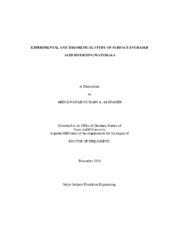| dc.description.abstract | The purpose of matrix stimulation in carbonate reservoirs is to bypass damaged zones and increase the effective wellbore area. This can be achieved by creating highly conductive flow channels known as wormholes. A further injection of acid will follow a wormhole path where the permeability has increased significantly, leaving substantial intervals untreated. Diverting materials such as surfactant-based acids plays an important role in mitigating this problem. In this study and for the first time, 20-inch long cores were used to conduct the acidizing experiments in two configurations, single coreflood and parallel coreflood.
The major findings from performing single coreflood experiments can be summarized as follows: The acid injection rate was found to be a critical parameter in maximizing the efficiency of using surfactant-based acids as a diverting chemical, in addition to creating wormholes. The maximum apparent viscosity, which developed during viscoelastic surfactant acid injection, occurred over a narrow range of acid injection rates. Higher injection rates were not effective in enhancing the acidizing process, and the use of diverting material produced results similar to those of regular acids. The amount of calcium measured in the effluent samples suggests that, if the acid was injected below the optimum rate, it would allow the acid filtrate to extend further ahead of the wormhole; at some point, it would trigger the surfactant and form micelles. When the acid injection rate was lowered further to a value of 1.5 cm3/min, the fluid front developed in more progressive fashion and the calcium concentration was more significant, continuing to increase until wormhole breakthrough
On the other hand, the parallel coreflood tests show several periods that can be identified from the shape of the flow rate distribution entering each core. The acid injection rate was confirmed as influencing the efficiency of the surfactant to divert acid. Acid diversion was noted to be most efficient at low rates (3 cm3/min). No significant diversion was noted at high initial permeability ratios, at least for the given core length. The use of surfactant-based acid was also found to be constrained by the scale of the initial permeability ratio. For permeability ratios greater than about 10, diversion was insufficient. | en |


